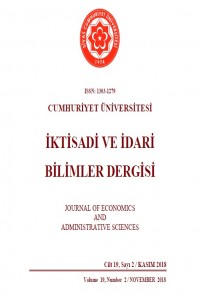Öz
This study investigates the relationship
between income inequality and crime in the United States. For this purpose,
2004 and 2016 years are chosen to represent before and after great recession
period to understand the potential relationship income and crime. All data set
are taken from National Longitudinal Survey conducted by the United States
Bureau of Labor Statistics. Crime variables are categorized big and small
crimes based on the value of crimes. Because the crime variables are highly
skewed, a quantile regression approach can be more appropriate then a regular
regression. As result of the quantile regression approach, income inequality is
positively associated with the crime variables. Considering the crime variables
only the big crime variable which includes attack a property or using illegal
substance has negative effect on income level over all quantile range.
Anahtar Kelimeler
Employment Status Inequality Crime Level Quantile Regression
Kaynakça
- Altindag, D. T. (2012). Crime and unemployment: Evidence from Europe, International Review of Law and Economics, 32(1), 145-157.
- Baltagi, B. H.(2006) Estimating an economic model of crime using panel data from North Carolina, Journal of Applied Econometrics 21(4): 543-547.
- Becker, G S. (1968) Crime and punishment: An economic approach. The economic dimensions of crime. Palgrave Macmillan UK, 13-68.
- Brush, J. (2007). Does income inequality lead to more crime? A comparison of cross-sectional and time-series analyses of United States counties, Economics letters, 96(2), 264-268.
- Ehrlich, I., (1973) Participation in illegitimate activities: a theoretical and empirical investigation, Journal of Political Economy 81,521–565.
- Eide, E and Showalter, M(1998). The Effect of School Quality on Student Performance. A Quantile Regression, Approach, Economics Letters 58:3, 345–50
- Gillani, S. Y. M., Rehman, H. U., and Gill, A. R. (2009). Unemployment, poverty, inflation and crime nexus: cointegration and causality analysis of Pakistan, Pakistan Economic and Social Review, 79-98.
- Heinemann, A., and Verner, D. (2006). Crime and violence in development: A literature review of Latin America and the Caribbean.
- Jiang, S., Lu, M., and Sato, H.(2012) Identity, inequality, and happiness: Evidence from urban China., World Development, 40.6: 1190-1200.
- Koenker, R. 2005. Quantile Regression. Cambridge Univ. Press, New York.
- Lee (2002), Lee, Y. and Daniel (2002), Income Inequality and Crime: Cointegration Analysis and Causality Tests. Shippensburg University.
- Levin, J (2001), For Whom the Reductions Count: A Quantile Regression Analysis of Class Size on Scholastic Achievement, Empirical Economics, 26:1, 221– 46
- M. Kelly (2000) Inequality and Crime, Review of Economics and Statistics, 82 (4), pp, 530–539
- NLSY (National Longitudinal Surveys) retrieved from National Bureau of Economic Research, https://www.nlsinfo.org/
- Omotola, J.S. (2012). Combating Poverty for Sustainable Human Development in Nigeria: The Continuing Struggle. Journal of Poverty, 12(4), 496-517.
Öz
This study investigates the relationship between income inequality and crime in the
United States. For this purpose, 2004 and 2016 years are chosen to represent before
and after great recession period to understand the potential relationship income and
crime. All data set are taken from National Longitudinal Survey conducted by the
United States Bureau of Labor Statistics. Crime variables are categorized big and
small crimes based on the value of crimes. Because the crime variables are highly
skewed, a quantile regression approach can be more appropriate then a regular
regression. As result of the quantile regression approach, income inequality is
positively associated with the crime variables. Considering the crime variables only
the big crime variable which includes attack a property or using illegal substance has
negative effect on income level over all quantile range.
Anahtar Kelimeler
Employment Status Inequality Crime Level Micro Analysis Quantile Regression
Kaynakça
- Altindag, D. T. (2012). Crime and unemployment: Evidence from Europe, International Review of Law and Economics, 32(1), 145-157.
- Baltagi, B. H.(2006) Estimating an economic model of crime using panel data from North Carolina, Journal of Applied Econometrics 21(4): 543-547.
- Becker, G S. (1968) Crime and punishment: An economic approach. The economic dimensions of crime. Palgrave Macmillan UK, 13-68.
- Brush, J. (2007). Does income inequality lead to more crime? A comparison of cross-sectional and time-series analyses of United States counties, Economics letters, 96(2), 264-268.
- Ehrlich, I., (1973) Participation in illegitimate activities: a theoretical and empirical investigation, Journal of Political Economy 81,521–565.
- Eide, E and Showalter, M(1998). The Effect of School Quality on Student Performance. A Quantile Regression, Approach, Economics Letters 58:3, 345–50
- Gillani, S. Y. M., Rehman, H. U., and Gill, A. R. (2009). Unemployment, poverty, inflation and crime nexus: cointegration and causality analysis of Pakistan, Pakistan Economic and Social Review, 79-98.
- Heinemann, A., and Verner, D. (2006). Crime and violence in development: A literature review of Latin America and the Caribbean.
- Jiang, S., Lu, M., and Sato, H.(2012) Identity, inequality, and happiness: Evidence from urban China., World Development, 40.6: 1190-1200.
- Koenker, R. 2005. Quantile Regression. Cambridge Univ. Press, New York.
- Lee (2002), Lee, Y. and Daniel (2002), Income Inequality and Crime: Cointegration Analysis and Causality Tests. Shippensburg University.
- Levin, J (2001), For Whom the Reductions Count: A Quantile Regression Analysis of Class Size on Scholastic Achievement, Empirical Economics, 26:1, 221– 46
- M. Kelly (2000) Inequality and Crime, Review of Economics and Statistics, 82 (4), pp, 530–539
- NLSY (National Longitudinal Surveys) retrieved from National Bureau of Economic Research, https://www.nlsinfo.org/
- Omotola, J.S. (2012). Combating Poverty for Sustainable Human Development in Nigeria: The Continuing Struggle. Journal of Poverty, 12(4), 496-517.
Ayrıntılar
| Birincil Dil | İngilizce |
|---|---|
| Konular | İşletme |
| Bölüm | Makaleler |
| Yazarlar | |
| Yayımlanma Tarihi | 30 Kasım 2018 |
| Gönderilme Tarihi | 9 Ağustos 2018 |
| Yayımlandığı Sayı | Yıl 2018 Cilt: 19 Sayı: 2 |
Cumhuriyet Üniversitesi İktisadi ve İdari Bilimler Dergisi Creative Commons Atıf-GayriTicari 4.0 Uluslararası Lisansı (CC BY NC) ile lisanslanmıştır.

